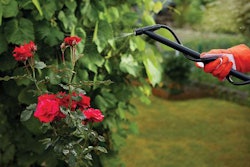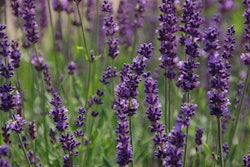
Asian longhorned beetle (ALB) (Anoplophora glabripennis) and Emerald ash borer (Agrilus planipennis) are tree killers. Unlike our native tree borers, these non-natives are capricious killers; the beetles will choose both healthy as well as unhealthy tree victims. However, beyond their original Asian addresses and their indiscriminate tastes in trees, these beetles have little else in common. (Read the history of these beetles here.)
Unfortunately, EAB and ALB have been found in the some of the same geographical locations in North America and the convergence of these killers in the same location may create confusion; when people hear “ALB,” they may think “EAB” and vice versa. The two beetles are like apples to oranges in almost all aspects including: biology; behavior; spread; distribution and management options.
The Killer’s MO
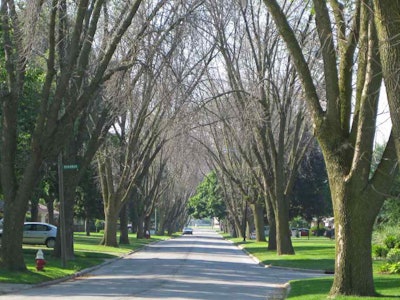
Trees considered “good hosts” of ALB include: Acer (all maple species); Aesculus (horsechestnuts and buckeyes); Ulmus (elms) and Salix (willows). Trees that are considered “other hosts” include: Betula (birches); Platanus (sycamore/planetrees); Populus (poplars); Albizia (mimosa); Cercidiphyllum (katsura); Fraxinus (ashes); Koelreuteria (golden raintree); Sorbus (mountainash) and Celtis (hackberry).

The speed with which these borers kill trees depends heavily on differences in larval feeding behavior, coupled with morphological differences in their host trees. EAB only attacks ash trees, and all ash species are “ring porous” which means water and nutrients are only transported from the roots upward through the single outermost xylem (i.e. white wood) ring.
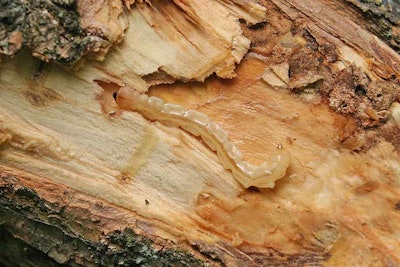 EAB Larva in the Phloem
EAB Larva in the PhloemAlthough EAB larvae are phloem-feeders, as the larvae gain size (girth), they start etching this critical outermost xylem ring. Consequently, trees may die quickly as EAB larvae girdle trees by consuming the phloem and etching the single functioning xylem ring to destroy the trees’ “plumbing.” The thinning of tree canopies is a key diagnostic feature of an EAB infestation.
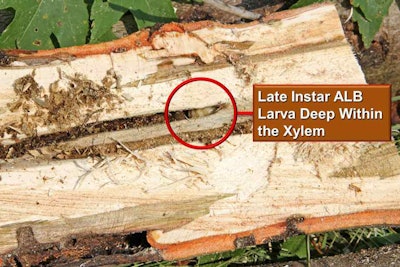
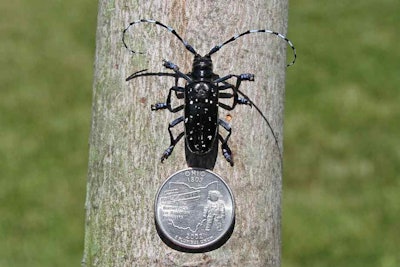 ALB Adult
ALB AdultClues to Detecting the Killers
While EAB and ALB will target both healthy as well as stressed hosts, always remember they will only select live hosts. There are many native wood boring beetles that bore into dead tree trunks and branches and the native borers may produce look-a-like holes and larval tunnels.
ALB is a large beetle, measuring around 1 1/4 to 1 1/2 inches length. They have characteristically long antennae (“longhorned”), with each one measuring as long as 2 inches. The beetles produce large, almost perfectly round exit holes measuring around 3/8 to 3/4 inches in diameter. Since the larvae feed deep within the xylem, the exit holes extend deep into the tree. Inserting a pencil into an exit hole is a good way to determine whether the hole was produced by a xylem-emerging borer. This is the so-called “pencil test.” Deep woodpecker holes on living maple trees are also a good indicator that larvae are living deep in the xylem.
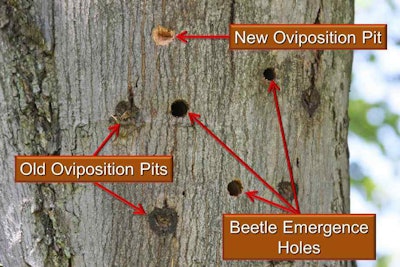
EAB is a much smaller beetle, measuring around 3/8 to 5/8 inches in length. Adults have a flat back and round “belly” when viewed head-on, which is the orientation of the beetle as it emerges from trees. Thus, EAB creates a characteristic “D-shaped” emergence hole. Owing to the beetle’s small size, the holes are only around 1/8 inches across the flat side of the “D.” Females are much less deliberate in their egg laying behavior compared to ALB; they do nothing more than insert their ovipositors into bark crevices to deposit eggs. There are no tell-tale pits.
The relatively small size of the EAB exit holes makes finding them difficult until trees are heavily infested. Adding to the challenge is the tendency for the beetles to first infest the uppermost and outermost branches and then gradually work their way inward and downward with each successive generation. Consequently, exit holes are usually found at eye-level only when infested trees have been almost completely utilized by the beetles. However, unusually intense woodpecker activity on living ash trees is a good indicator that the trees are infested with EAB larvae. Since EAB larvae live in the phloem, woodpecker holes are very shallow and often accompanied by a dramatic removal of bark plates, most often in late winter to early spring.
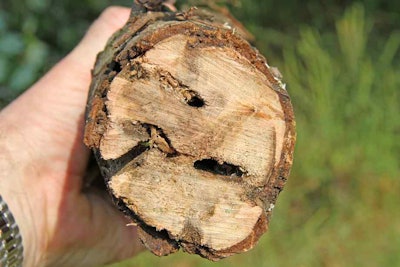 Tunneling Damage: Structural Weakening of the Xylem
Tunneling Damage: Structural Weakening of the XylemKey tree symptoms used to detect EAB infestations include thinning canopies, heavy interior (epicormic) growth and bush-like basal growth; however, these are not dependable symptoms that can be used to detect ALB infestations. A much more dependable symptom for discovering new ALB infestations is branch breakage, which is a result of the structural branch weakening caused larval feeding damage to the xylem.
The differences in beetle sizes and exit holes, as well as infestation patterns within trees, provides a partial explanation as to why EAB went undetected for so long compared to ALB. As a consequence, EAB benefited from years of human-assisted spread before its discovery in North America. In fact, dendrochronology studies indicate the beetle was living in the Detroit suburb for around 21 years before its detection in 2002.
The natural spread of the two beetles is also very different. The much smaller EAB adults are very good fliers and easily disperse. While ALB adults are relatively good fliers, they take flight less frequently than EAB, perhaps because their large bodies require much more energy to launch and remain airborne. Thus, ALB tends to stay and continually re-infest trees until the trees die and are no longer able to support a new generation. As a result, ALB does not spread very fast between trees compared to EAB.
However, the ALB situation in Ohio represents several “firsts.” It was the first time the beetle had been found in a rural area dominated by farm land, and it is the southern-most ALB infestation to be found in North America. The Ohio infestations illustrate how this beetle may pop-up where least expected: Bethel is a rural community located far from major transportation hubs. The take-home message is to never assume ALB is “somewhere else.”
Management Options
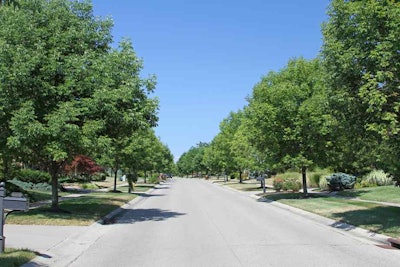 Treated Ash Trees
Treated Ash TreesEAB is now found in multiple locations in North America with large populations in many U.S. states, as well as Ontario and Quebec, Canada. Therefore, the beetle represents a clear and present danger to ash trees throughout a large area of North America. ALB was first found on the continent in 1996, but even now, populations remain small and isolated compared to EAB.
The management strategy for ALB is eradication with the overarching goal to eliminate ALB from North America. The beetle has successfully been eradicated from Chicago, Illinois, Staten Island, Manhattan, and Islip, New York, two locations in New Jersey and from Toronto. However, successful eradication depends on continued vigilance and early detection. While ALB was declared eradicated from Toronto in April, 2013, an infestation was found in September 2013 in Mississauga, which is located just west of Toronto. Like elsewhere, this new infestation appears to be connected to the original Toronto population; vigilance remains the operative word.
Although EAB cannot be eradicated because it is so widespread, ash trees can be successfully protected against EAB through treatments with systemic insecticides. However, it is important to remember treatment success is measured by the health of the canopies, and not by the number of beetles killed. EAB larvae feed exclusively on the phloem where they are vulnerable to systemic insecticides. While the larvae are the primary target of the insecticides, adult EAB beetles are also killed when they feed on the leaves of systemically treated trees. Systemic insecticide treatments are highly effective in EAB suppression; however, the overarching management goal is very different from ALB. Maintaining a full canopy does not require 100% efficacy as every EAB beetle does not need to be killed.
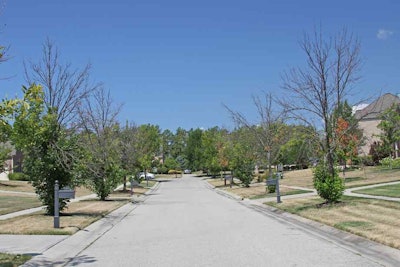 Untreated Ash Trees
Untreated Ash TreesEradication using insecticides means the treatments must be 100-percent effective, or very nearly so. While ALB larvae start out feeding on the phloem, they quickly bore into the xylem. Unfortunately, this places the larvae out of the reach of systemic insecticides. If a tree already has ALB larvae in the xylem, the insects will successfully complete their development, pupate and new adults will emerge and disperse even if the tree is treated.
Insecticides have been used in a support role in ALB eradication programs in North America. However, unlike EAB where the larvae are the primary target, ALB adults are the primary target. Adults feed on twig and leaf tissue during the maturation period, which is the time required for eggs to develop inside the females, and the beetles may consume insecticides in the phloem tissue as they are feeding. Regrettably, while some ALB adults are killed, the number of adults killed will not meet the standards required for eradication. Field experiments conducted in China under highly controlled conditions using small (2-4-inch diameter) uniform trees found that ALB density was reduced by 71-90 percent. While this level of control may be sufficient for protecting trees, it is not adequate to justify the use of insecticides as a primary control tool when the goal is the complete eradication of the beetle.
Achieving high adult mortality is further challenged by the extended period that adults are active during the season, limitations associated with product label restrictions, and the fact that size matters; efficacy is uncertain on large trees. Thus, while insecticides have been used in a support role in ALB eradication programs in North America, they have always been used in conjunction with other eradication tools and primarily outside of the core infestation zones.
The most effective ALB eradication approach in terms of the time and money required to complete the eradication has been the removal and destruction of infested trees as well as high-risk host trees located within a prescribed distance to known infested trees. This provides a “safety” buffer in case lightly infested trees escape detection. Unfortunately, this approach may translate into the loss of large numbers of trees.
Although the overarching goal is to prevent ALB from escaping eradication to follow the same catastrophic spread trajectory as EAB in North America, gaining public acceptance of the “greater good” associated with suffering a heavy loss of trees to the chainsaw can present a serious challenge to ALB eradication plans. Of course, much is at stake with ALB given the beetle’s wide host range; it is potentially the most devastating non-native tree killer to have ever arrived on our shores. 
By Joe Boggs, Amy Stone and Dan Herms
Joe Boggs is an assistant professor with the Ohio State University (OSU) Extension and OSU Department of Entomology. He works as a commercial horticulture educator for OSU Extension, Hamilton County (Cincinnati). Boggs can be reached via e-mail at [email protected].
Amy Stone is a horticulture educator and county director with OSU Extension, Lucas County (Toledo). She is the state-wide co-ordinator for the OSU Extension, EAB/ALB Team. She can be contacted at [email protected].
Dan Herms is a professor and chairperson of the OSU Department of Entomology. His area of expertise includes interactions between insects and woody plants including impacts of invasive insects on forest communities. He can be reached via e-mail at [email protected].

